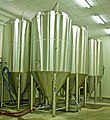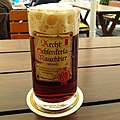Introduction

Beer is one of the oldest alcoholic drinks in the world, the most widely consumed, and the third most popular drink after water and tea. Beer is produced by the brewing and fermentation of starches from cereal grains—most commonly malted barley, although wheat, maize (corn), rice, and oats are also used. The fermentation of the starch sugars in the wort produces ethanol and carbonation in the beer. Most modern beer is brewed with hops, which add bitterness and other flavours and act as a natural preservative and stabilising agent. Other flavouring agents, such as gruit, herbs, or fruits, may be included or used instead of hops. In commercial brewing, natural carbonation is often replaced with forced carbonation.
Some of the earliest writings refer to the production and distribution of beer: the Code of Hammurabi included laws regulating it, and "The Hymn to Ninkasi", a prayer to the Mesopotamian goddess of beer, a recipe for it.
Beer is distributed in bottles and cans and is also commonly available on draught, particularly in pubs and bars. The brewing industry is a global business, consisting of several dominant multinational companies and many thousands of smaller producers ranging from brewpubs to regional breweries. The strength of modern beer is usually around 4% to 6% alcohol by volume (ABV).
Beer forms part of the culture of many nations and is associated with social traditions such as beer festivals, as well as activities like pub crawling, pub quizzes, and pub games. (Full article...)
Selected articles -
Yeasts are eukaryotic, single-celled microorganisms classified as members of the fungus kingdom. The first yeast originated hundreds of millions of years ago, and at least 1,500 species are currently recognized. They are estimated to constitute 1% of all described fungal species.
Some yeast species have the ability to develop multicellular characteristics by forming strings of connected budding cells known as pseudohyphae or false hyphae, or quickly evolve into a multicellular cluster with specialised cell organelles function. Yeast sizes vary greatly, depending on species and environment, typically measuring 3–4 µm in diameter, although some yeasts can grow to 40 µm in size. Most yeasts reproduce asexually by mitosis, and many do so by the asymmetric division process known as budding. With their single-celled growth habit, yeasts can be contrasted with molds, which grow hyphae. Fungal species that can take both forms (depending on temperature or other conditions) are called dimorphic fungi. (Full article...)Selected brand -
Gulden Draak (Dutch for Golden Dragon) is a dark Belgian beer with high alcohol by volume (10.5%), brewed by Brouwerij Van Steenberge in Ertvelde, East Flanders. It is named after the golden dragon at the top of the belfry in Ghent.
There are several variants, including Gulden Draak 9000 Quadruple. (Full article...)Selected biography -

Did you know (auto-generated) -

- ... that Ein Samiya, which provides the water for Taybeh, the first beer brewed in Palestine, was depopulated in 2023 after harassment by neighboring Israeli settlers?
- ... that Figueroa Mountain Brewing Company claimed in 2017 to be brewing beer "around the clock – 22 and a half hours every day" in order to keep up with demand?
- ... that some online social and "Barstool conservatives" spent their Christmas holidays arguing about whether a beer promotional calendar was "demonic"?
- ... that Jaega Wise co-hosted the television series Beer Masters alongside musician James Blunt?
- ... that the country song "Beer Beer, Truck Truck" was based on a viral TikTok video by Erynn Chambers intended to satirize country music?
- ... that 100 beerhouses were licensed in Brighton (population 40,000) in the first week after the Beerhouse Act 1830 was enacted?
Selected brewery -
Camerons Brewery is an English brewery established by John William Cameron in Stranton, Hartlepool, County Durham, in 1865. It is the largest independent brewer in the North East of England, with a brewery capacity of 1.5 million hectolitres (900,000 hl production in 2012) and a tied estate of 75 houses. It is one of the oldest industrial concerns in Hartlepool, and has historically been one of the largest employers.
After one hundred years of growth through brewery acquisitions, the company had an estate of 750 licensed premises throughout the North East and North Yorkshire by the 1960s. The company subsequently struggled as the economy of its trading heartland suffered, and as it underwent a succession of owners with little experience of pub and brewery management. Camerons lost its independence to Ellerman Lines in 1974, and was acquired by the Barclay Brothers in 1983 and then Brent Walker in 1989. Brent Walker spun-off the majority of the tied estate as a separate company called Pubmaster, which was acquired by Punch Taverns in 2003. (Full article...)Selected image -

General images
Beer topics
Categories
Selected quote -
| “ | Well ya see, Norm, it's like this... A herd of buffalo can only move as fast as the slowest buffalo, and when the herd is hunted, it is the slowest and weakest ones at the back that are killed first. This natural selection is good for the herd as a whole, because the general speed and health of the whole group keeps improving by the regular killing of the weakest members. In much the same way, the human brain can only operate as fast as the slowest brain cells. Excessive intake of alcohol, as we know, kills brain cells, but naturally it attacks the slowest and weakest brain cells first. In this way, regular consumption of beer eliminates the weaker brain cells, making the brain a faster and more efficient machine. That's why you always feel smarter after a few beers. | ” |
The Buffalo Theory as explained on an episode of Cheers by Cliff Clavin to his drinking buddy, Norm Peterson |
Related portals
Beer lists
Things you can do
This list is transcluded from the tasks list page, to edit, click here
This is a list of single time tasks that need action. Once you have completed them, please remove them from the list.
 |
Here are some tasks awaiting attention:
|
WikiProjects

WikiProject Beer is an association of Wikipedians with an interest in beer and beer-related subjects. They have come together to coordinate the development of beer and brewery articles here on Wikipedia. Additionally, other groups have formed other projects that entertain subjects that are directly related to beer, bartending and pubs. Additionally, the mixed drinks project covers topics that include beer cocktails. If any of these subjects pique your interest, please feel free to visit their projects. These groups would love to have you participate!
| Parent project: WikiProject Food and Drink | |
| Child projects: | Task forces: (All inactive) |
|
|
| Related projects: | |
Associated Wikimedia
The following Wikimedia Foundation sister projects provide more on this subject:
-
 Commons
Commons
Free media repository -
 Wikibooks
Wikibooks
Free textbooks and manuals -
 Wikidata
Wikidata
Free knowledge base -
 Wikinews
Wikinews
Free-content news -
 Wikiquote
Wikiquote
Collection of quotations -
 Wikisource
Wikisource
Free-content library -
 Wikiversity
Wikiversity
Free learning tools -
 Wiktionary
Wiktionary
Dictionary and thesaurus
More portals
Purge server cache





























































